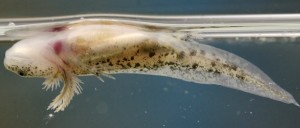
October 15, 2013
What could belly-up axolotls (Ambystoma mexicanum) and hungry tiger salamander tadpoles have to tell us about anything strange seen in Loch Ness?
Perhaps quite a bit, actually. It’s all a matter of specific gravity, evolutionary ploys, and how to tool around a large Scottish lake if you’re born without a swim bladder.
My thanks to Christopher Hjelte, a reader of my blog who recently sent me a link to an interesting video about research into axolotls at Blackburn College in Carlinville, Illinois. Midway though this 2 minute piece, we learn of a very odd and previously undocumented behavior first observed and later filmed by Blackburn students studying these aquatic salamanders. A behavior that might possibly bear some implications for surface sightings of much larger cousins elsewhere!
About Steve Plambeck
Steven G. Plambeck is an amateur researcher, armchair paleoanthropologist, and by dint of a long standing interest in the phenomenon associated with Loch Ness may be called an armchair cryptozoologist as well without taking offense. He is the author of "The Loch Ness Giant Salamander" blogspot, and arguably the current leading proponent of the giant amphibian theory regarding the nature of that possible creature.
Filed under Cryptozoology, Lake Monsters, Loch Ness Monster